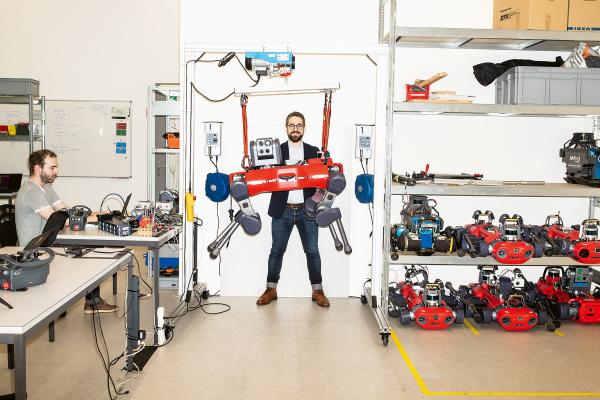Helmets, carabiners, headlamps, and carefully rolled-up climbing ropes are stored on the wooden shelves. Two-way radios are plugged into their chargers. In summer, the avalanche airbags are tucked away in the corner of the almost 40 square meter equipment room of the Swiss Alpine Rescue (ARS). However, once the first snow appears, the probes, shovels, flags, and blankets are brought back into service. Here, in the basement of the community center, the Engelberg section of the Swiss Alpine Club stores its equipment. Dino Ineichen is holding the most important tool of all in his hand: his smartphone. It emits a shrill beep. The 27-year-old looks at the Alpine Rescue Mission Control app and reacts immediately to the alarm. He confirms the operation and assumes the role of team leader. He can immediately see the available support team members, who have been informed automatically. Ineichen quickly knows who will soon be arriving for the operation. “In the past, countless phone calls were necessary, but now everything is very quickly and perfectly organized,” he says. The app gives everyone the information they need about the upcoming operation: 27 years old, female, brown hair, dressed in black. A woman is missing, her last WhatsApp status update was at the Alpenrösli mountain restaurant. Is it a routine case? “There’s no such thing as routine. The uncertainty factor is always there,” says Ineichen, as he gets the coordinated high-tech operation underway.

We’re with the mountain rescue team in Engelberg, Switzerland. It’s getting pretty cramped in the equipment room now. Ten women and men jostle in front of a large topographical map. The Engelberg section covers a large area. Ineichen marks the primary search area with a red marker. Local knowledge and experience are important when deciding on a strategy. It quickly becomes clear that search dogs and aerial support from a drone should help. The two dog handlers Michael Stutz and René Geisser divide up the areas to the left and right of the hiking trail into the valley. Rolf Gisler prepares for drone deployment. In addition to their love of nature and the mountains, they are united by their attitude toward their volunteer work. “We like to help people. Even if every operation doesn’t end well,” says Ineichen, and everyone agrees with him. “I always wondered who rescues people who have had an accident from the mountains when the weather is bad,” recalls Thomas Hurschler. The trained carpenter has been one of these volunteer helpers for the past 13 years. The Engelberg rescue team in action. See the drone recordings here: https://hvr.ch/reportage.html
The drone geek
The operation is going according to plan. Rolf Gisler is driving along Wasserfallstrasse toward Niedersurenen in his red minivan. He aims for the highest point, parks his vehicle, and unpacks a flat-screen TV and several suitcases. Every move has been carefully orchestrated. The expert in charge of drones at Swiss Alpine Rescue has his own multimedia services company. He describes himself as a technology and drone geek. A look in his suitcase confirms this description. Inside there are three DJI Enterprise Series drones, professional equipment of different generations, each weighing around one kilogram and adaptable to all requirements. He has a 4K camera with 30x zoom, along with various apertures and filters to increase the contrast depending on the brightness. He also has a rechargeable battery with integrated heating, which is important for use at low temperatures, and a thermal imaging camera that helps when rescuing fawns. In 2022, drones helped save more than 3,000 fawns from accidental death by heavy-duty mowers. “I decide what I need for the operation,” says Gisler. Today, he doesn’t need the crash dummy for contact with rock faces in narrow gorges or in trees, nor does he need attachments for lights, speakers, or flashing lights.
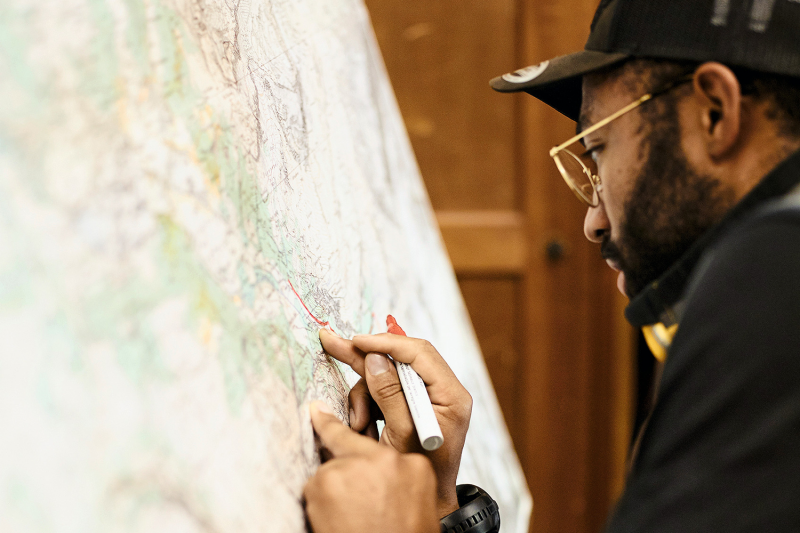
1. The Engelberg section covers a large area. Dino Ineichen marks the search area.
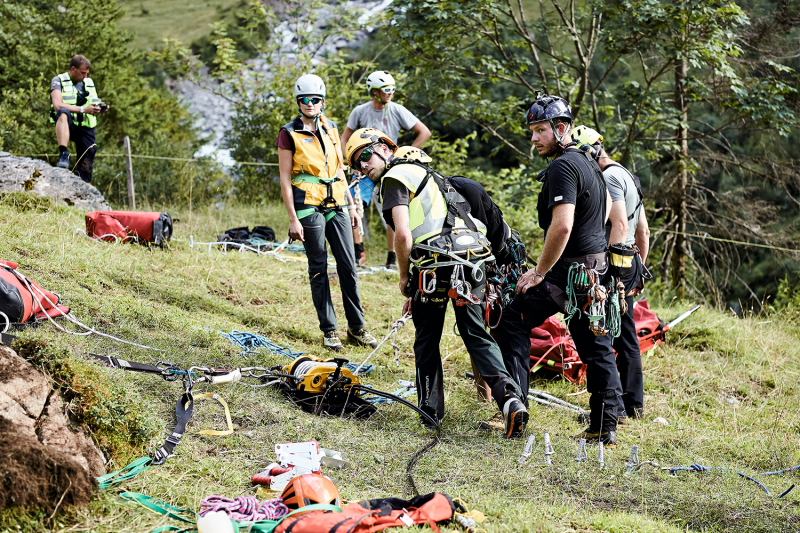
2. All buckled up: The rescue team members rappel around 100 meters with the rescue stretcher.
Meanwhile, Hans von Rotz joins the team. The 61-year-old has been head of the Engelberg section since 2010 – following in his father’s footsteps. Helping others is in his DNA. He heads a team of 37 men and women, who are called out between 10 and 20 times a year. Around two-thirds of all emergency calls concern missing persons. In the majority of cases, every second counts. “We mostly use technical aids – from helicopters to cell phone locators to drones or avalanche beacons,” says von Rotz, adding: “We still need our eyes and ears.” The increase in the number of operations in recent years is mainly due to changes in recreational habits since the beginning of the coronavirus pandemic. More and more people are being drawn to the mountains. However, many do not have the required physical fitness, equipment, and mountain experience to match their chosen routes. It is not without reason that the Alpine Rescue team exceeded the thousand mark for the first time last year with 1,071 operations. “People watch a YouTube video and then jump headlong into the freeride paradise on Mount Titlis,” explains Rotz, “but we’re not here to judge, we’re here to rescue.”
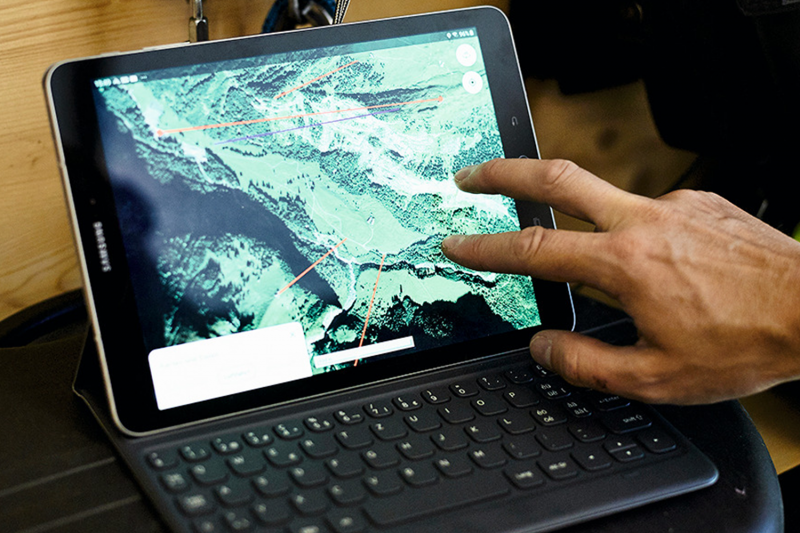
3. The drone expert uses various maps on the tablet to check the conditions, where ropes are tensioned, and where there are no-fly zones.
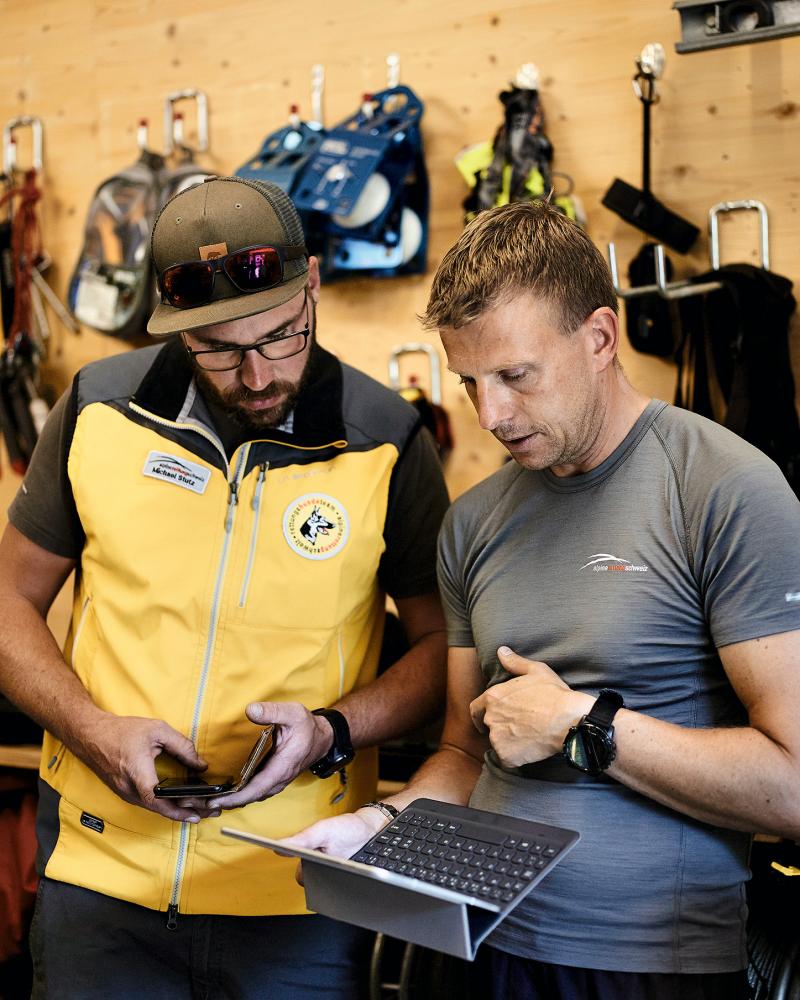
4. The strategy is clear: Search dogs and aerial support from a drone. The search areas of the hiking trail into the valley are split up.

Marco Sicher is fascinated : The maxon specialist for aerospace customer projects accompanies the rescue operation.
The rescue chief looks over Gisler’s shoulder. Before he starts the drone, he stops to think. “I look at various maps on the tablet to see what I need to watch out for, where ropes are tensioned, where there are no-fly zones,” he says. Dino Ineichen reports over the radio: “The dogs are on the way.” Gisler presses the push-to-talk button and gives the green light: “I’m ready too.” He places the drone on a box and starts the propellers using the remote control he’s wearing around his neck. In seconds the whirring aircraft is in the air. He follows the images on the large screen with great concentration. With him is Marco Sicher from the Business Unit Aerospace at maxon. He oversees development projects together with customers and is fascinated by these practical insights. “Being able to see a real-life application up close shows the untapped potential that lies in the commercial use of drones,” says Sicher. Ineichen suddenly announces over the radio: “We’ve found her! It was the dogs.” Gisler steers the drone in the direction of the Aa Gorge, descending a bit deeper as it heads toward the mountain stream, and is successful. “OK, I see her too,” says Gisler, pointing to the monitor and focusing the camera on the site beneath the rock. “She’s waving, she seems to be fine. But it looks like she’s injured her leg.” The dogs were faster, but while they’re already eating a piece of Cervelat (Switzerland’s national sausage) as a reward, Gisler’s work with the drone continues. With visual support from the air, he can give the rescue team important tips for the impending winch rescue from a depth of around 100 meters and identify obstacles and problem areas. “I see things that nobody else can see right now,” he says.
Technology performance is crucial
Humans and machines complement each other perfectly. Digitalization is progressing at breakneck speed. In rescue operations, autonomous robots for particularly dangerous situations as well as sensors, satellites, mobile communication systems, and digital networking have become indispensable. “Quality and precision make the difference,” says Marco Sicher. “The earlier we sit down with potential customers during development, the more expertise we can bring to the table. It’s becoming increasingly important that in such a complex system the components can communicate with each other and provide feedback to the operator.”
“What happens when it rains?” asks Sicher. “We had a situation where water got into the electronics. The drone fell to the ground like a stone from the sky. You need a specially designed drone for use in the rain,” explains Gisler. Sicher nods. From his work at maxon, he understands the importance of extensive testing of protection against water, the ingress of solid particles, and other environmental influences to ensure safety. Battery performance can also save lives in an emergency. Gisler’s drone can remain in the air for half an hour. Longer would be even better. Lighter too.
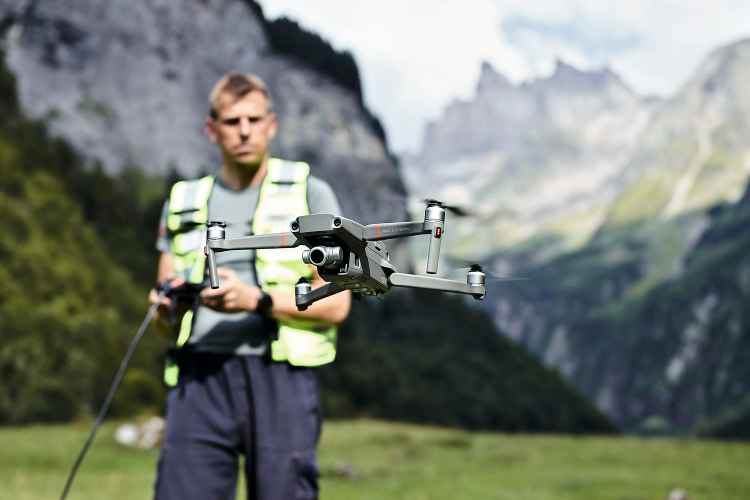
Meanwhile, the rescue team is ready for the final step. The winch is prepared for the recovery operation with a secure three-point anchor in the rock. Peter Zumbühl grabs the first-aid backpack. The ventilator, oxygen, defibrillator, and other supplies required for emergency medical care weigh 15 kilograms. Zumbühl and Adi Bauer abseil around 100 meters with the rescue stretcher. At the scene of the accident, Zumbühl splints the injured woman’s right leg before she is safely lifted into the stretcher and strapped in. Supported by manual effort on the pulley block, the rescue is successfully completed in just under 30 minutes. It’s easy to see how much a light, powerful electric motor could have helped as a winch drive. “You took your time today,” jokes Daniela Abächerli. She then gets up and high-fives her rescuers. Everyone laughs. Today’s rescue is actually just an exercise. Abächerli enjoyed playing the part of the missing woman. Now she can go home. As can the mountain rescue team – at least until the next smartphone alert from Alpine Rescue Mission Control.
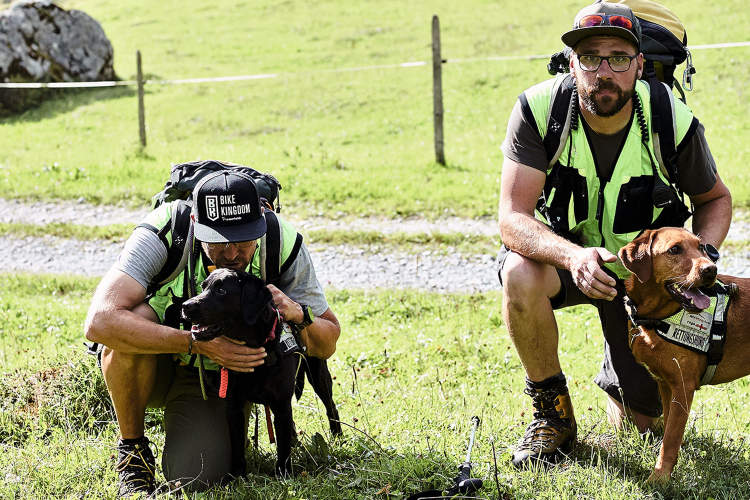
Q&A
Ready, set, search!
One of the most important mountain rescue workers is of the four-legged variety. Despite all the sophisticated technical support available in the search and location of missing persons, almost no operation takes place without a dog handler. Michael Stutz has worked with the team at the SAC Engelberg rescue station as a dog specialist for several years. With him, of course, is his five-year-old Labrador, Fox.
Michael, at what point do you know whether a dog is suitable for this type of work?
Labradors are very friendly. They love people. This becomes apparent during the first six months of training, when you’ll see that the dog is interested in the work and finds it fun.
How does the dog actually search for someone?
Unlike police dogs, our search dogs don’t need a trail. Fox just needs the human scent (skin particles) of the missing person. He can therefore search a large area in a short time.
How does Fox indicate that he’s found someone?
Fox wears a small piece of rope on his collar, known as a bringsel. As soon as I say the word “Search!” he darts away, sometimes up to 500 meters. When he comes back with the bringsel in his mouth, I know he’s found something. He then leads me to the location. We don’t need it in winter if there’s an avalanche, because he’ll paw at the snow instead.
Welcome to Drone Valley
Switzerland is the world’s leading location for the development of key technologies and commercial applications for drones. The Swiss Federal Institutes of Technology in Lausanne (EPFL) and Zurich (ETH Zurich) and the University of Zurich are among the best technological universities in the world and are leaders in flying robotics and unmanned systems. This has led to the area between the two universities being nicknamed “Drone Valley”. In recent years, more than 80 startups have been established here, creating 2,500 jobs.
Latest issue
Read the current issue of maxon’s driven magazine featuring exciting stories, surprising facts and interesting technical articles on all aspects of drive technology.
Discover it on our website: maxongroup.com/driven



